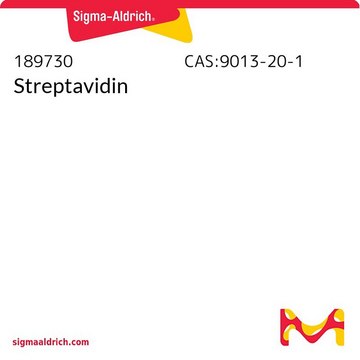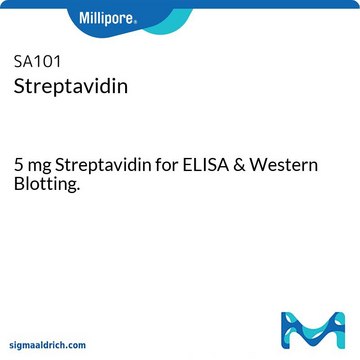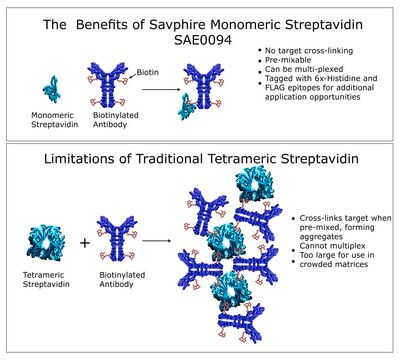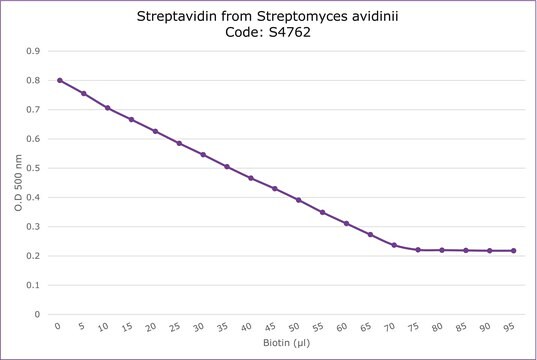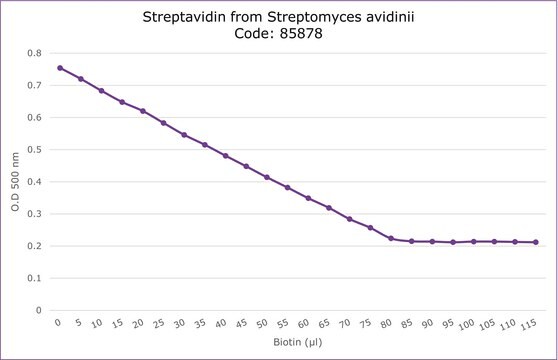S9415
Streptavidin−Maleimide from Streptomyces avidinii
Synonyme(s) :
Streptavidin Conjugate
Se connecterpour consulter vos tarifs contractuels et ceux de votre entreprise/organisme
About This Item
Produits recommandés
Ampleur du marquage
4-10 mol maleimide per mol Streptavidin
Niveau de qualité
Adéquation
suitable for direct conjugation to compounds containing free sulfhydryl groups
Température de stockage
−20°C
Catégories apparentées
Description générale
Streptavidin conjugated compounds may be used in avidin/strepavidin:biotin-based detection systems.
Streptavidin is a protein produced by the bacterium Streptomyces avidinii. It has four binding sites for biotin, as does avidin. Both have been used extensively as probes in immunochemical systems, conjugated to antibodies, enzymes or fluorochromes. However, avidin is highly basic (pI ~ 10.5), compared to streptavidin (pI ~ 5-6). Avidin has a slightly higher binding capacity for biotin than streptavidin does, but it has glycosylated side chains which give higher backgrounds in blotting techniques than does streptavidin, which is not a glycoprotein. Streptavidin is more resistant than avidin to dissociation into subunits by guanidinium chloride.
Application
Maleimide Activated Streptavidin is used to prepare streptavidin-protein conjugates with proteins, peptides and other molecules that contain a free sulfhydryl (-SH) group. Activated streptavidin presents an available maleimide group that reacts with sulfhydryl-containing molecules.
Forme physique
Lyophilized powder containing sodium citrate.
Notes préparatoires
Streptavidin, from Streptomyces avidinii, activated with maleimidocaproic acid N-hydroxysuccinimide ester.
Clause de non-responsabilité
Unless otherwise stated in our catalog or other company documentation accompanying the product(s), our products are intended for research use only and are not to be used for any other purpose, which includes but is not limited to, unauthorized commercial uses, in vitro diagnostic uses, ex vivo or in vivo therapeutic uses or any type of consumption or application to humans or animals.
Code de la classe de stockage
11 - Combustible Solids
Classe de danger pour l'eau (WGK)
WGK 3
Point d'éclair (°F)
Not applicable
Point d'éclair (°C)
Not applicable
Équipement de protection individuelle
Eyeshields, Gloves, type N95 (US)
Faites votre choix parmi les versions les plus récentes :
Déjà en possession de ce produit ?
Retrouvez la documentation relative aux produits que vous avez récemment achetés dans la Bibliothèque de documents.
Les clients ont également consulté
B Mygind et al.
European journal of biochemistry, 59(2), 365-372 (1975-11-15)
1. The transport of pyrimidine mucleosides into cells of Escherichis coli has been investigated in mutant strains which cannot metabolize these nucleosides. Such cells transport and concentrate purimidine mucleosides several hindredfold. 2. The transport is inhibited by energy poisons and
Abraham Wolcott et al.
The journal of physical chemistry. B, 110(11), 5779-5789 (2006-03-17)
Quantum dots (QDs) have been increasingly used in biolabeling recently as their advantages over molecular fluorophores have become clear. For bioapplications QDs must be water-soluble and buffer stable, making their synthesis challenging and time-consuming. A simple aqueous synthesis of silica-capped
New procedures for preparation and isolation of conjugates of proteins and a synthetic copolymer of D-amino acids and immunochemical characterization of such conjugates.
F T Liu et al.
Biochemistry, 18(4), 690-693 (1979-02-20)
Kitagawa, T., et al.
Chemical & Pharmaceutical Bulletin, 29(4), 1131-1131 (1981)
R J Duncan et al.
Analytical biochemistry, 132(1), 68-73 (1983-07-01)
A synthesis of the N-hydroxysuccinimide ester of S-acetylthioacetic acid is described. This material is stable when stored dry and has advantages over the currently available reagents used to introduce sulfhydryl groups into a variety of proteins. Proteins modified with this
Notre équipe de scientifiques dispose d'une expérience dans tous les secteurs de la recherche, notamment en sciences de la vie, science des matériaux, synthèse chimique, chromatographie, analyse et dans de nombreux autres domaines..
Contacter notre Service technique